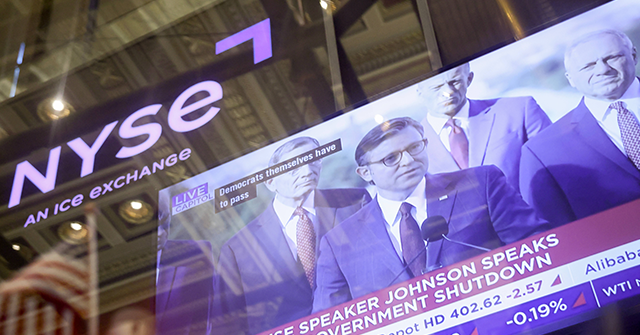Washington Panics, Markets Shrug: The Shutdown Reality Check
The government closed its doors this week after the Senate Democrats blocked Republican attempts to pass appropriations bills or a stopgap resolution. While this has captured the attention of the denizens of the nation’s capital, the actual financial capital and labor of the U.S. is likely to proceed as if nothing much has changed.
Shutdowns are not cataclysmic events but accounting quirks with political theater layered on top. The real questions are how long this shutdown lasts and whether President Trump uses the lapse to shrink the federal workforce in ways that allow for a serious move toward reprivatizing the U.S economy and defunding the parts of the government that serve far left interests out of sync with the Trump administration’s policies.
Bank of America estimates a full shutdown subtracts about a tenth of a percentage point from GDP growth for every week it continues. That’s not nothing, but history says the economy promptly makes up the lost ground once the lights come back on. The 2013 shutdown temporarily knocked six-tenths off growth. The 2018–19 version was four-tenths in one quarter. Both were quickly reversed.
That’s even less of a concern when the economy is growing at a robust pace. Gross Domestic Product, the government’s official scorecard for the economy, grew at a 3.8 percent pace in the second quarter. The Atlanta Fed’s GDPNow barometer reads the economy as growing at a 3.9 percent pace in the third quarter. Trump’s fiscal and regulatory policies–domestic tax cuts, tariffs, energy abundance, and deregulating industry—are just now coming on line to accelerate growth. Shaving a few tenths of a point off growth now won’t hurt.
Furloughed or Fired: Federal Job Losses Aren’t an Economic Signal
Some 750,000 to 800,000 federal employees are furloughed, millions more are working without pay. Contractors get no back pay, which makes their losses permanent—a real, if narrow, demand shock. But even that is overstated since a lot of the work will need to be made up later. Mostly, the effects are concentrated on Washington, DC, and its suburbs—one of the wealthiest areas of the country.
Russ Vought, the White House budget chief, has said that the administration plans to use the funding lapse to downsize government payrolls by reducing headcounts in the parts of the government that are not compliant with the direction of the democratically elected executive. Unlike past shutdowns, this one isn’t just a pause button—it could be a delete key. Enough reductions might even nudge the unemployment rate up, as displaced federal workers are sent to find jobs in the private economy.
It’s important to keep in mind, however, that federal layoffs are not a macroeconomic signal. When private employers fire workers, it usually means output is falling. When the government fires workers, it means the government wants fewer workers. That may reduce consumer spending, but it says nothing about the health of the private economy. If anything, it’s fiscal policy by another name. Government workers losing their jobs is not a signal of an economic downturn.
What’s more, pushing federal workers out of the nest and forcing them to fly in the private economy is likely to be economically beneficial. The civilian federal workforce, excluding postal workers, is up by around ten to 15 percent since the first Trump administration. Returning those workers to the private sector could help address the labor shortage many employers have complained about. Instead of contributing to the cost of government, they would contribute to economic output. As we’ve said before, the growth of government employment is inflationary, and shrinking government payrolls is disinflationary because government workers consume goods and services produced and sold by the private sector but do not produce them.
The data blackout is arguably the most interesting wrinkle. With no jobs report this Friday, inflation data is in doubt. The Fed, deprived of its favorite dashboard lights, may decide to cut rates at its October meeting for “risk-management” reasons. One imagines that Fed Chair Jerome Powell would rather err on the side of easing than of explaining later why he didn’t.
The Market Tends to Like Shutdowns
Markets have seen shutdowns before. Across 20 episodes since 1976, the S&P 500 has averaged a gain of 0.05 percent—call it a rounding error. In Trump’s first term, stocks rose 10 percent during a 34-day shutdown.
Why the indifference? Because markets understand what Washington’s pundit class pretends it doesn’t: shutdowns are temporary. GDP lost today is GDP gained tomorrow when workers get back pay or find new jobs and spending resumes. Investors care about growth, profits, Fed policy, inflation, consumer spending, and the geopolitics of global trade—things that actually change the economic weather. Almost anything but whether several hundred thousand government workers are getting paid on time while Democratic senators filibuster the budget.
The press treats every shutdown like the asteroid about to kill the dinosaurs. It might not sell papers anymore, but it definitely triggers clicks and shares. Markets, by contrast, treat it like what it usually is—a Washington melodrama that doesn’t dent the real economy.
The post Breitbart Business Digest: Why Wall Street and the Real Economy Yawn at Shutdowns appeared first on Breitbart.




